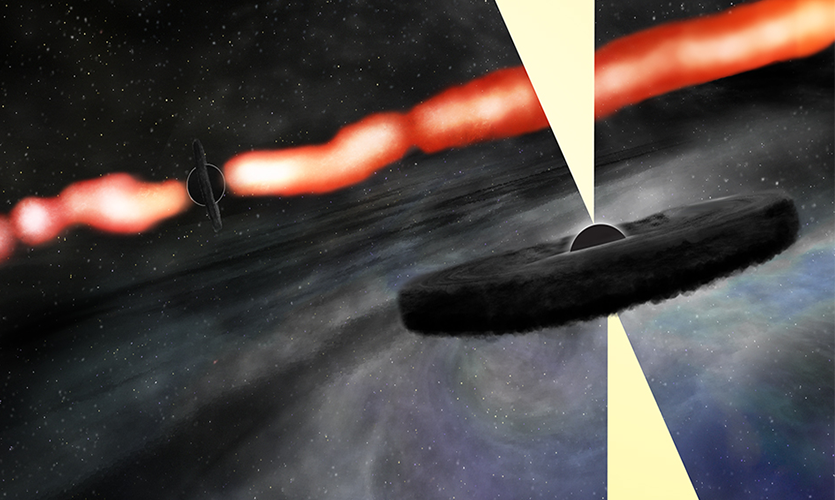LJMU astronomer helps uncover new object in famous galaxy

Pointing the Very Large Array (VLA) radio telescope in New Mexico at a famous galaxy for the first time in two decades, a team of astronomers from the Astrophysics Research Institute at Liverpool John Moores University and the National Radio Astronomy Observatory got a big surprise, finding that a bright new object had appeared near the galaxy's core.
The object, the scientists concluded, is either a very rare type of supernova explosion or, more likely, an outburst from a second supermassive black hole closely orbiting the galaxy's primary, central supermassive black hole.
All large galaxies are thought to have a large black hole - typically a million times more massive than our Sun - at their centre, and for a small subset of those galaxies the black hole is active, accelerating fast jets of relativistic matter out into intergalactic space. What makes some of these black holes active, and other black holes (such as the one at the centre of our own Milky Way galaxy) inactive, is unknown.
Astronomers have long suspected the collisions between galaxies play a key role - a hypothesis supported by the discovery of this new source of radio emission in one of the most powerful active galaxies in the Universe.
"This new object may have much to tell us about the history of this galaxy," said Dr Daniel Perley, from the Astrophysics Research Institute, and lead author of a paper in the Astrophysical Journal announcing the discovery. "We've suspected for a long time that the brightest and most spectacular galaxies owe their nature to collisions with other galaxies. This fills in an important piece of that puzzle."
The astronomers observed Cygnus A, a well-known and often-studied galaxy discovered by radio-astronomy pioneer Grote Reber in 1939. The radio discovery was matched to a visible-light image in 1951, and the galaxy, some 800 million light-years from Earth, was an early target of the VLA after its completion in the early 1980s. Detailed images from the VLA published in 1984 produced major advances in scientists' understanding of the superfast "jets" of subatomic particles propelled into intergalactic space by the gravitational energy of supermassive black holes at the cores of galaxies.
"The VLA images of Cygnus A from the 1980s marked the state of the observational capability at that time," said Rick Perley, of the National Radio Astronomy Observatory (NRAO). "Because of that, we didn't look at Cygnus A again until 1996, when new VLA electronics had provided a new range of radio frequencies for our observations. The new object does not appear in the images made then. However, the VLA's upgrade that was completed in 2012 made it a much more powerful telescope, so we wanted to have a look at Cygnus A using the VLA's new capabilities," Perley said.
Daniel and Rick Perley, along with Vivek Dhawan, and Chris Carilli, both of NRAO, began the new observations in 2015, and continued them in 2016.
"To our surprise, we found a prominent new feature near the galaxy's nucleus that did not appear in any previous published images. This new feature is bright enough that we definitely would have seen it in the earlier images if nothing had changed," said Rick Perley. "That means it must have turned on sometime between 1996 and now," he added.
The scientists then observed Cygnus A with the Very Long Baseline Array (VLBA), a linked array of ten radio telescopes spanning North America, in November of 2016, clearly detecting the new object. A faint infrared object also is seen at the same location in Hubble Space Telescope and Keck observations, originally made between 1994 and 2002.
The infrared astronomers, from Lawrence Livermore National Laboratory, had attributed the object to a dense group of stars, but the dramatic radio brightening is forcing a new analysis.
What is the new object?
Based on its characteristics, the astronomers concluded it must be either a supernova explosion or an outburst from a second supermassive black hole near the galaxy's centre. While they want to watch the object's future behaviour to make sure, they pointed out that the object has remained too bright for too long to be consistent with any known type of supernova.
"Because of this extraordinary brightness, we consider the supernova explanation unlikely," Dhawan said.
While the new object definitely is separate from Cygnus A's central supermassive black hole, by about 1500 light-years, it has many of the characteristics of a supermassive black hole that is rapidly feeding on surrounding material.
"We think we've found a second supermassive black hole in this galaxy, indicating that it has merged with another galaxy in the astronomically-recent past," Carilli said. "These two would be one of the closest pairs of supermassive black holes ever discovered, likely themselves to merge in the future."
The astronomers suggested that the second black hole has become visible to the VLA in recent years because it has encountered a new source of material to devour. That material, they said, could either be gas disrupted by the galaxies' merger or a star that passed close enough to the secondary black hole to be shredded by its powerful gravity.
“This would be like a patch of foam or oil resting on the surface of a body of water being elongated and then torn apart as the water goes down a drain whirlpool. We plan to obtain further observations using the VLA, VLBA, and the UK's e-MERLIN telescope in the coming months and years to test these different models, and to try to find similar objects in other galaxies,” Daniel Perley concluded.
The Astrophysics Research Institute is one of the world's leading authorities in astronomy and astrophysics


